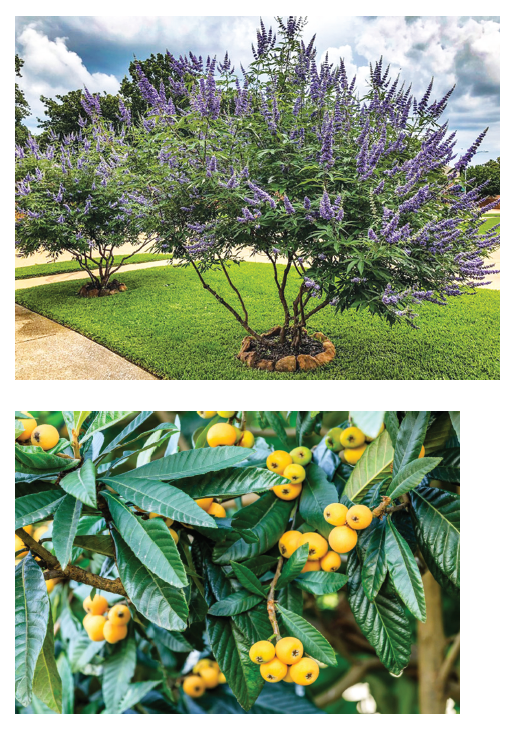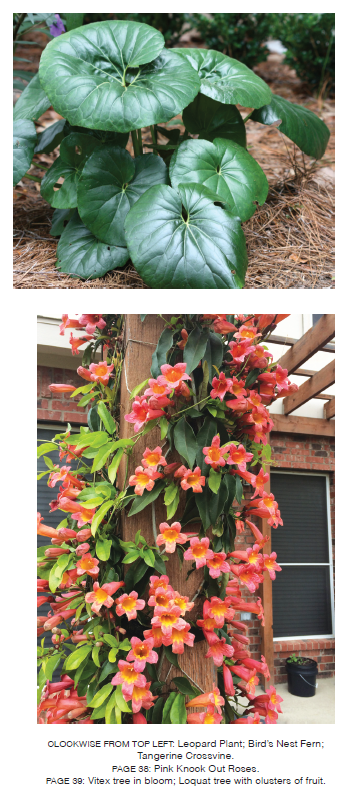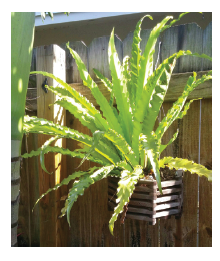Red Bud, Live Oak, Bradford Pear, Crape
Myrtle, Holly, Hawthorne, Red Tip Photinia,
Magnolias—all are “old reliables” that
came through the recent snow and ice
storm with barely a pause in their growth.
Unfortunately, countless others were lost
and are too numerous to list, but there were
some surprises as well.
A number of these survivors certainly
merit an honorable mention and should be
considered to replace some of those that
recently succumbed to the frigid winter.
TREES
Empress Tree
In the winter, the branches are covered with furry,
pea sized buds that will explode into purple blooms
at the first sign of spring. The fragrance is a cross
between gardenia and jasmine. In summer, the
tree forms a dense canopy of huge tropical leaves
measuring nearly a foot across.
This is an easy-to-grow flowering tree with no
significant insect or disease problems, and it tolerates
drought and almost any kind of soil. One of the most
environmentally beneficial trees in the world, the
Empress Tree’s large leaves act as giant air filters,
pulling pollution out of the air at a remarkable rate
then releasing high amounts of beneficial oxygen.
Please keep in mind that the Empress Tree is, in fact,
one of the fastest growing trees in the world. It can
grow up to 20 feet tall in its first year, and reaches
maturity in just 10 years. Be prepared for this rampant
growth and plan wisely where you plant this tree.
Texas Ebony Tree
Part of the Mimosa family, this tree is an attractive
landscape piece that is underutilized and underappreciated. A medium-sized shade tree with a dense
canopy, the Ebony is native to Texas with a dark mahogany
wood in shades of brownish purple.
It is a remarkably drought-tolerant evergreen that features
cream-colored clusters of blooms produced continuously
from late spring to fall, drawing the full attention of
bees and birds. The Texas Ebony tolerates almost all soil
conditions, and they are known to suffer few problems
with pests or disease.
 Vitex
Vitex
It blooms from late spring to early fall with long, upright
spikes of pleasantly fragrant flowers in shades of pink, lilac,
and white that attract butterflies and bees. Also called the
“chaste tree,” the Vitex is a native of China, but it has a
long history in the U.S.
It was first cultivated in 1670, and since that time it has
become naturalized throughout the Southern part of the
country. Many southerners use it as a replacement for
lilacs.
FRUIT TREES
Loquat
Ornamental as well as practical, these become excellent
lawn specimen trees with whirls of glossy foliage and a
naturally attractive shape. Its size is well-suited to home
landscapes with large clusters of attractive fruit that stand
out against the dark green, tropical foliage, adding to the
tree’s visual appeal.
Kumquat
This tree has large round very sweet fruit; both skin and
fruit are edible. A heavy bearer of fruit that is well known
to survive cold temperatures, Kumquat trees can also be
grown in containers.
Tangerines
Relatively cold-hardy compared to other citrus, the fruit
may freeze at 32 degrees, but the branches and leaves of a
Tangerine tree can normally withstand temperatures of 21
degrees. The leaves may curl up but will return to normal
once the weather warms.
Valencia Orange
These trees need full sun exposure of six to eight hours
a day, and the soil should be fertile and well-drained. To
ensure healthy growth, water regularly with a slow-water
drip, soaker, or bubble hose, and feed three times a year
with a specially formulated citrus tree fertilizer.
BULBS AND TUBERS
Amaryllis
This species was introduced into cultivation at the
beginning of the 18th Century and has since naturalized
throughout lower elevations and coastal areas since these
environments mimic their native South African habitat.
They reproduce slowly by either bulb division or
seeds. Plant in fall and early spring for blooms from late
December through June.
Crinum
The grand crinum, crinum lily, spider lily, cemetery lily, and
swamp lily are large, perennial, clump-forming herbs from
Asia and Africa that have naturalized along the coastlines of
Florida and Texas. The foliage of the crinum resemble that
of amaryllis though with a coarser appearance. Through
summer and fall months, blooms appear in shades of
white, pink, red, striped, and multicolored.
The crinum is a true “pass-along” treasure only seen
occasionally in plant nurseries. This long-lived gem requires
little care and may be seen in abandoned sites and
cemeteries, totally neglected but thriving and flourishing.
Tuberose Begonia
This begonia grows from bulbous parts, tubers (bulbs),
rhizomes (underground stems), or fibrous root systems
(mat-like growths) that store nutrients and water.
Propagate by cutting sections of the root and planting in
prepared soil.
 ODDITIES
ODDITIES
Bird’s Nes t Fern
 This fern is native to tropical
areas like Asia, Australia, and
Hawaii where they are often
found in palm trees. It comes
in a wide variety of colors
and textures, although it is
most regularly found with
large, simple, tropical-like
fronds that are light green in
color with crinkled or wavy
leaves rising from a central rosette.
This fern is native to tropical
areas like Asia, Australia, and
Hawaii where they are often
found in palm trees. It comes
in a wide variety of colors
and textures, although it is
most regularly found with
large, simple, tropical-like
fronds that are light green in
color with crinkled or wavy
leaves rising from a central rosette.
The bird’s nest fern prefers medium to bright indirect light
and regular watering every two weeks. Avoid watering
directly into the plant but water around the plant instead.
Bridal Wreath
A spirea that requires little care, this medium-sized shrub
with arching branches features a cascading waterfall of
thick sprays of white double blooms.
Crossvine
Occasionally called a trumpet flower, it is a semi-green
climbing vine with trumpet-shaped blooms that occur in
clusters of orange and yellow from mid-spring through late
summer. The Crossvine is a favorite of hummingbirds.
Knock out Roses
Shrubby in form with clusters of flowers that bloom
continually through December, this rose can reach up to
four feet in height. They are largely free of blackspot and
other fungal diseases.
Often called “knocks,” these shrubs bloom in successive
cycles with a short rest in between. Fertilize with a good
organic rose formula, remembering to discontinue use
of fertilizer at the end of July or early August when they
prepare for dormancy.
Confederate Rose
This large shrub from China has adapted to the southern
states, but it is actually not a rose at all, rather a member
of the hibiscus family. Oversized leaves and a curious cycle
of blooming are indigenous characteristics of this plant.
The flowers open white but over the course of several
days change color to eventually become pink and finally
deep rose in hue.
Leopard Plant
An evergreen, clump-forming perennial that features
unusual but stunning foliage and bright yellow flowers in
fall months, the Leopard Plant is native to Japan and Korea.
Bees and butterflies pollinate the blooms and the resulting
seeds may be sown for continued plant production.
Preferring rich moist soil and part sun to shade, it will
thrive with consistent watering and is rarely bothered by
insects or disease.